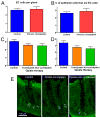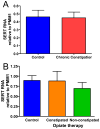Mucosal serotonin signaling is altered in chronic constipation but not in opiate-induced constipation
- PMID: 20010921
- PMCID: PMC2872481
- DOI: 10.1038/ajg.2009.683
Mucosal serotonin signaling is altered in chronic constipation but not in opiate-induced constipation
Abstract
Objectives: Changes in mucosal serotonin (5-HT) signaling have been detected in a number of functional and inflammatory disorders of the gastrointestinal (GI) tract. This study was undertaken to determine whether chronic constipation (CC) is associated with disordered 5-HT signaling and to evaluate whether constipation caused by opiate use causes such changes.
Methods: Human rectal biopsy samples were obtained from healthy volunteers, individuals with idiopathic CC, and individuals taking opiate medication with or without occurrence of constipation. EC cells were identified by 5-HT immunohistochemistry. 5-HT content and release levels were determined by enzyme immunoassay, and mRNA levels for the synthetic enzyme tryptophan hydroxylase-1 (TpH-1) and serotonin-selective reuptake transporter (SERT) were assessed by quantitative real-time reverse transcription PCR.
Results: CC was associated with increases in TpH-1 transcript, 5-HT content, and 5-HT release under basal and stimulated conditions, whereas EC cell numbers and SERT transcript levels were not altered. No changes in these elements of 5-HT signaling were detected in opiate-induced constipation (OIC).
Conclusions: These findings demonstrate that CC is associated with a pattern of altered 5-HT signaling that leads to increased 5-HT availability but does not involve a decrease in SERT expression. It is possible that increased 5-HT availability due to increased synthesis and release contributes to constipation due to receptor desensitization. Furthermore, the finding that elements of 5-HT signaling were not altered in the mucosa of individuals with OIC indicates that constipation as a condition does not lead to compensatory changes in 5-HT synthesis, release, or signal termination.
Conflict of interest statement
Gary M. Mawe, PhD
Meagan M Costedio: patient screening, obtaining consent, tissue acquisition, tissue processing, data analysis, and manuscript preparation and editing
Matthew D Coates: patient screening, obtaining consent, tissue acquisition, tissue processing, data analysis, and manuscript preparation and editing
Elice M Brooks: tissue acquisition, data acquisition, and data analysis
Lisa M Glass: data acquisition, and data analysis.
Eric K Ganguly: aided in conception of the project, acquiring IRB approval, obtaining informed consent, and tissue acquisition.
Hagen Blaszyk: evaluation of sections and blind scoring of inflammation levels in the chronic constipation component of the study
Allison L. Ciolino: evaluation of sections and blind scoring of inflammation levels in the opiate constipation component of the study
Michael J Wood: involved in obtaining informed consent, and tissue acquisition.
Doris Strader: involved in obtaining informed consent, and tissue acquisition.
Neil H Hyman: involved in study conceptualization, planning, and identifying potential candidates for the chronic constipation component of the study.
Peter L Moses: involved in study conceptualization, planning, obtaining informed consent, and tissue acquisition, data analysis, and manuscript preparation and editing
Gary M Mawe: involved in study conceptualization, planning, data analysis, and manuscript preparation and editing.
All authors reviewed and approved the manuscript prior to submission.
4.
Figures





References
-
- Erspamer V. Occurence of indolealkylamines in nature. In: Erspamer V, editor. Handbook of experimental pharmacology. Vol. 19. New York: Springer; 1966. pp. 132–181. 5-Hydroxtryptamine and related indolealkylamines.
-
- Gershon MD, Tack J. The serotonin signaling system: from basic understanding to drug development for functional GI disorders. Gastroenterology. 2007;132:397–414. - PubMed
-
- Mawe GM, Coates MD, Moses PL. Review article: intestinal serotonin signalling in irritable bowel syndrome. Aliment Pharmacol Ther. 2006;23:1067–76. - PubMed
-
- Costedio MM, Hyman N, Mawe GM. Serotonin and its role in colonic function and in gastrointestinal disorders. Dis Colon Rectum. 2007;50:376–88. - PubMed
-
- Spiller R. Serotonin and GI clinical disorders. Neuropharmacology. 2008 - PubMed
Publication types
MeSH terms
Substances
Grants and funding
LinkOut - more resources
Full Text Sources
Medical

